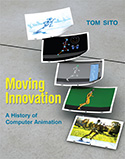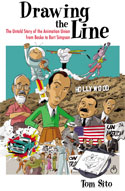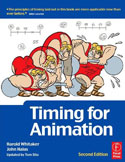“ Tom Sito is the perfect person to tell the story of the struggles of animators for decent wages and working conditions. He was the doubting Thomas anti-union kid who became a true believer and a local union president. In Drawing the Line, he effectively blends the cold historical facts with colorful anecdotes from his informants. Given his role as a union officer for several years, and the notoriously checkered history of Walt Disney’s treatment of union organizers, one might expect a totally jaundiced account of the critical moments in this history of the unionization of the animation industry. Yet, Sito manages to balance his account with an appreciation for the relative positions of the workers and their bosses.
My own telling of the Hollywood studio strikes from 1937 to 1947 in Hollywood’s Other Blacklist was largely shaped by the information provided by my co-author, Gene Mailes, an IATSE Local 44 prop worker who was blacklisted from the industry for his progressive union activities. In my struggle to make sense of all the double crosses and back stabbing that took place, I found myself attacking the corrupt union bosses as much as I attacked the management with whom the union bosses colluded. And this felt intrinsically bad to me because it was not my intention to undermine unionism in the entertainment industry. Tom Sito develops this very idea in a much more effective manner than my own book could ever do, mainly because he was the proverbial “St. Paul knocked off his horse.” He was a young animator who saw only the downside to the union in his early years in the industry. His talent gave him a shot back in the early 1970s at working alongside animation veterans who had been instrumental in the establishment of an animators’ union, the Screen Cartoonists’ Guild. As he learned about the inner workings of the industry, Sito slowly became aware that his pay and working conditions were the product of a long struggle by the union to wrest some small measure of control from the studio bosses.
The book covers a broad swath of animation history from the early days of Disney, Ub Iwerks, Max and Dave Fleischer up to the 3D work of Pixar. At each stage in the development of the technology, Sito provides the blow by blow struggles of union organizers and the texture of the work environment, especially the role that humor played at a form of solidarity among the artists. Yet, he does not shy away from the real downside of the business, especially the consistent theme of over-work and lack of adequate compensation. He pays special attention to the major problem that has confronted animators during the last 25 years, namely runaway production moving to distant lands where low wage artists were grateful for the chance to animate Hollywood films at a fraction of the rate earned by union workers in southern California.
One small quibble with the book is that there is a certain amount of almost verbatim repetition in various sections. A little editing of these passages would improve the book but overall, this is a great story told by a man who really appreciates the animation business and mindset of the animators as artists and workers.”
My own telling of the Hollywood studio strikes from 1937 to 1947 in Hollywood’s Other Blacklist was largely shaped by the information provided by my co-author, Gene Mailes, an IATSE Local 44 prop worker who was blacklisted from the industry for his progressive union activities. In my struggle to make sense of all the double crosses and back stabbing that took place, I found myself attacking the corrupt union bosses as much as I attacked the management with whom the union bosses colluded. And this felt intrinsically bad to me because it was not my intention to undermine unionism in the entertainment industry. Tom Sito develops this very idea in a much more effective manner than my own book could ever do, mainly because he was the proverbial “St. Paul knocked off his horse.” He was a young animator who saw only the downside to the union in his early years in the industry. His talent gave him a shot back in the early 1970s at working alongside animation veterans who had been instrumental in the establishment of an animators’ union, the Screen Cartoonists’ Guild. As he learned about the inner workings of the industry, Sito slowly became aware that his pay and working conditions were the product of a long struggle by the union to wrest some small measure of control from the studio bosses.
The book covers a broad swath of animation history from the early days of Disney, Ub Iwerks, Max and Dave Fleischer up to the 3D work of Pixar. At each stage in the development of the technology, Sito provides the blow by blow struggles of union organizers and the texture of the work environment, especially the role that humor played at a form of solidarity among the artists. Yet, he does not shy away from the real downside of the business, especially the consistent theme of over-work and lack of adequate compensation. He pays special attention to the major problem that has confronted animators during the last 25 years, namely runaway production moving to distant lands where low wage artists were grateful for the chance to animate Hollywood films at a fraction of the rate earned by union workers in southern California.
One small quibble with the book is that there is a certain amount of almost verbatim repetition in various sections. A little editing of these passages would improve the book but overall, this is a great story told by a man who really appreciates the animation business and mindset of the animators as artists and workers.”
-- Mike Neilsen, Wesley College
_______________




